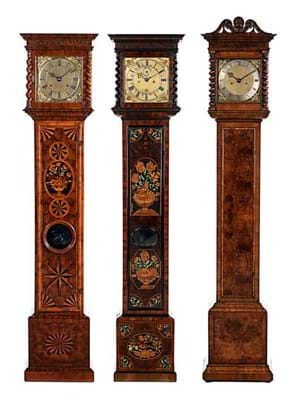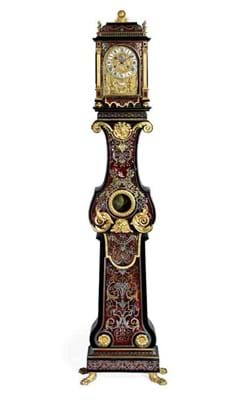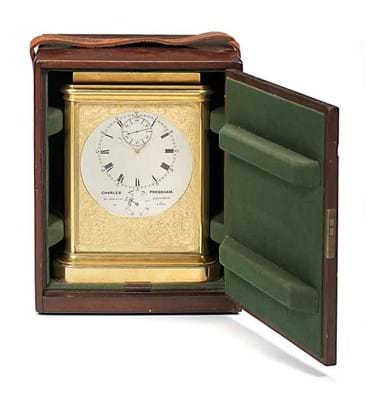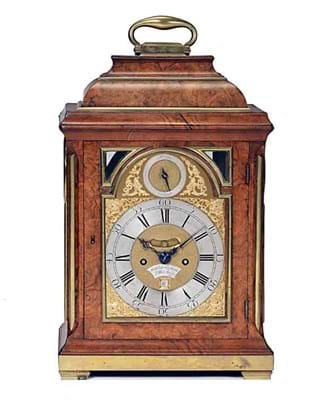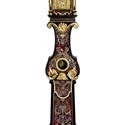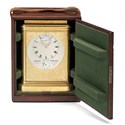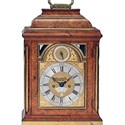However, it is the vulnerability of their wooden cases which was apparent at London's pre-Christmas horological offerings. Across the board, the most sought-after signatures on dials appeared in modified or replica cases - or even without a case at all - and nearly all the top sellers had been altered in some way.
The highest clock price of the season was seen at Christie's (25/20/12% buyer's premium), who now put clocks into their decorative arts sales.
The 12-lot selection at King Street on November 3 included a small c.1675-80 table clock by Thomas Tompion. The ebony case, with alterations to the plinth, was just 12¼in (31cm) high, handle down, and was one of the few early prenumbered examples from this Golden-Age maker which have gilt-metal repoussé basket tops, here modelled with birds, swags and foliate designs.
It had a 6in (15cm) square dial and an eight-latched pillar movement with strike and pull quarter repeat. The top and bottom of the backplate were gilded and engraved with Dutch tulips, with a plain central section covered by a false plate.
This feature, apparently unique for a Tompion clock, concealed the lever for the repeat mechanism, possibly to hide its technical innovation and prevent copying.
It also covered the bolt-and-shutter maintaining power release lever, possibly a later amendment replacing an earlier preselect system for the repeat work.
Formerly in the Vehmeyer collection in the Netherlands, it sold to Richard Garnier at £250,000 against an estimate of £150,000-200,000.
Meanwhile, Bonhams (25/20/12% buyer's premium) now hold the only dedicated clock sales in the capital and it was standing room only at their sale of Fine Clocks, Barometers and Scientific Instruments on December 3.
There was a shaky start with the failure of the projected top lot, a rare quadrant with the badge of King Richard II, dated 1396, which stalled at £140,000, just shy of its lower estimate. This left the following 128 clocks and barometers some ground to catch up, but keen bidding in the room and on the phones, together with a couple of after-sales, totted up selling rates of 76 per cent by lot and 75 by value, totalling £1m. Private buyers carried off most of the top lots.
A Tompion miniature ebony table clock, numbered 215 and dated c.1693, led the day here too. The movement had seven latched pillars with pivotted verge escapement, inside rack striking and rise and fall pendulum regulation. The high-quality engraving on the 5½in x 4½in (13 x 11cm) dial was by Graver 155, responsible for the front plate of the British Museum's Mostyn Tompion.
The movement was housed in a high-quality, well-proportioned replica case of ebony on a white oak carcass, 11in (28cm) high, handle up, almost certainly made in the 20th century. This was the fifth time this clock had been on the market in 28 years. Last sold at Sotheby's, London in 2005 for £70,000, it took £140,000 at Bonhams from a UK collector on the phone. Auctioneer James Stratton thought that in its original case it could have climbed to £500,000.
There were 11 carriage clocks on offer, of which the three examples by English makers were the most keenly contested.
A rare mid-19th century repeater in an engraved gilt-bronze case by James McCabe, complete with its original brassbound mahogany travelling case, saw a room-versus-phone battle. Estimated at £8000-12,000, it was won by paddle 219 in the room at £28,000.
However, it was another mid-19th century example, one by Charles Frodsham, which took the top carriage clock price. This giant engraved gilt-brass timepiece, 12in (30cm) high, was of exhibition quality, with a fusee movement and Earnshaw-type chronometer escapement and was of one-month duration with power reserve indicator.
It was numbered AD 1/FMSS on the silvered circular dial and was unique in that it did not follow the standard numbering system used by Frodsham.
It was speculated that it may have been produced to commemorate Frodsham's year as Master of the Worshipful Company of Clockmakers in 1855 and shown at the Paris Exhibition that year.
It came with its original mahogany travelling case with a pull-out slide which revealed its original tipsy key. Estimated at £30,000-50,000, it was contested by two phone bidders up to £90,000 when they were beaten by a late-entry phone bid of £95,000 from a Continental collector.
Longcase Clocks
The highlight of the longcases was a rare late-17th century example by another highly collectable London maker, Joseph Knibb.
With a provenance from the Wetherfield collection, the one-month duration mechanism was in a 6ft (1.95m) high walnut marquetry case. The hood had barley twist columns and the trunk door had corner inlays of ebony and walnut and inlaid roundels flanking an oval marquetry panel above a large circular lenticle and an eight-pointed inlaid star.
The 10in (25cm) dial had a Knibb-style skeletonised chapter ring and the six-pillar movement had Knibb's characteristic butterfly rating nut for the pendulum suspension spring.
It sold just under its low estimate to a UK collector in the room for £110,000.
A very similar 17th century small longcase had all the appearance of one from Knibb's workshop. It again had a skeletonised chapter ring and was in an attractive - "glowing" as James Stratton described it - inlaid marquetry case, with rising hood.
Indeed, it is illustrated in R.A. Lee's definitive book The Knibb Family Clockmakers, where he attributes its olivewood case to Knibb's case-maker and notes the Knibb influence in its dial.
However, it lacked the magic name on the dial, being signed Robert Dingley, London and sold, as expected, at £26,000.
One buyer for whom the Knibb "look" was enough, bought a good, small 20th century Knibb reproduction longcase in a burr walnut case. This one had a plain chapter ring and a substantial movement with Knibb's Roman striking and 1¼ seconds pendulum. It took £6000, a price which many 18th and 19th century longcases now struggle to achieve.
Price Differences
The results for two other ostensibly quite similar clocks make for an interesting comparison.
Both were 17th century table clocks signed Eduardus East, Londini and in later cases, with upper estimates of £10,000.
So why did one, housed in a replica ebonised case, sell to the trade at a midestimate £8000, while a UK collector took the other, in a rectangular polished wood case, up to £40,000?
Certainly the lower-priced one had a plainer dial with all-over matting behind the chapter ring, while the other had fine quality foliate engraving to the corners and a larger finely engraved flowerhead centre.
The main difference, however, was in the movements and, said James Stratton, showed how the output from the same workshop could vary, with the less expensive movement in a traditional East style, while the pricier one showed a different feel and lightness of touch in its manufacture.
This difference in quality was perhaps a result of the commercial symbiosis which had developed between workshops, who would buy in movements from each other.
Another bracket clock which easily outstripped its estimate was signed William Webster, Exchange Alley, London and dated to the second quarter of the 17th century. This was in a substantial walnut case, 17.5in (45cm) high, which had many features found in cases used by the noted clockmaker John Ellicott.
Chief of these are the brass-bound mouldings, brass framings to the doors and frets, and the chamfered case corners.
The break-arch dial had a silvered chapter ring, matted centre with date and mock pendulum apertures, floral and foliate spandrels and strike/silent ring in the arch. The twin fusee movement had verge escapement, rack striking and trip repeat. Although clocks by Webster do not command such high prices as those by Ellicott, the quality of its case saw this example soar past its modest £6000-8000 guide, selling to a collector on the phone for £30,000.
Lantern Clocks
Lantern clocks have been seeing something of a re-evaluation, according to Mr Stratton. Certainly all eight here sold well. An online UK collector took three, including the most expensive - a rare First Period (1580-1640) striking example with early features such as shallow floral engraving to the dial plate and filigree frets rather than the later dolphin style.
As is often the case with lantern clocks of this age, it was unsigned and had been converted from balance wheel to anchor escapement. It sold at £22,000 (estimate 6000-8000).

